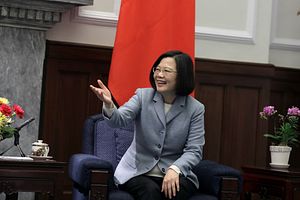For those who witnessed Taiwanese President Tsai Ing-wen’s National Day address on October 10, one interesting though not entirely unsurprising aspect was the very early mention of the Indo-Pacific concept in her remarks as a frame for the international landscape Taiwan faces. Tsai’s remarks, which came amid another active week for Taiwan’s international engagement, signified the country’s ongoing efforts to shape its place in the wider Indo-Pacific conception that has been gaining wider international attention in the past few years.
Not unlike other key Asian states, particularly since the Trump administration’s unveiling of its Free and Open Indo-Pacific (FOIP) which U.S. President Donald Trump first himself publicly articulated at the APEC Summit in Vietnam last year, Taiwan has been taking note of ongoing developments and attempting to frame its own response to this as well (See: “Trump’s Indo-Pacific Strategy in the Spotlight at 2018 Shangri-La Dialogue”). For Taiwan, despite the challenges that come with it, the Indo-Pacific conception offers it a platform to chart out collaborative path with like-minded states abroad and also address some of the significant domestic and foreign policy challenges it faces at home.
While Taiwan’s response is still a work in progress, several steps have been notable in this respect in 2018. Among these include the setting up of a new Indo-Pacific Affairs section in the Ministry of Foreign Affairs, public and private discussions with policymakers, scholars, and experts in the Indo-Pacific such as the United States and Japan, including on managing the challenge China poses to regional states, as well the continued advancement of Taiwan’s own New Southbound Policy under Tsai aimed at strengthening economic and social cooperation with Southeast Asia, South Asia, Australia, and New Zealand, as an example of its own contribution to the region (See: “What’s Next for Taiwan’s New Southbound Policy With ASEAN?”).
This week, some of the aspects of this response were on display during an active week for developments in this realm. Tsai’s National Day address on October 10, which referenced the Indo-Pacific in the fifth paragraph of her eighty-one divided paragraphs of prepared remarks, adroitly used the Indo-Pacific framework to tie together the connection between the challenges Taiwan and the region face and the measures Taipei is taking to address this on its own as well as with its partners. That connection was at the heart of the argument Tsai made in her speech: that the best way for Taiwan to defend itself was to make it indispensable to the world – its “niche for sustainable survival”.
The Yushan Forum, a two-day annual regional forum inaugurated last year which kicked off October 11, also showcased the elements of Taiwan’s New Southbound Policy. Kicking off the conference, Tsai in her keynote remarks briefly touched on the successes of the initiative thus far, offering metrics in areas such as tourism, education, trade, and investment. Panels on the first day also featured representatives from key ministries as well as speakers from partner countries in several of the key areas for the NSP, such as health, agriculture, and industrial innovation, in a format that facilitated a two-way conversation on these aspects.
To be sure, these public events can often highlight the opportunities that are being advanced more so than the challenges that remain, which are often the subject of more private conversations. In those conversations, with respect to the U.S. FOIP strategy some Taiwanese interlocutors unsurprisingly continue to express uncertainty about the broader future of the strategy as well as Taiwan’s role in it in spite of some of the positive signs they have seen so far with respect to U.S.-Taiwan relations itself (See: “Where Will US-Taiwan Relations Under Trump End Up?”). And as I have noted before, even the most ardent advancers of the New Southbound Policy understand that despite its successes, it is still early days and there is much more work to be done.
Nonetheless, as we hear more about the Indo-Pacific conception through 2018 and beyond, it will be interesting to see how Taiwan’s response shapes up given its role as both a key actor in the region in its own right as well as a part of the U.S. allied and partner network.

































